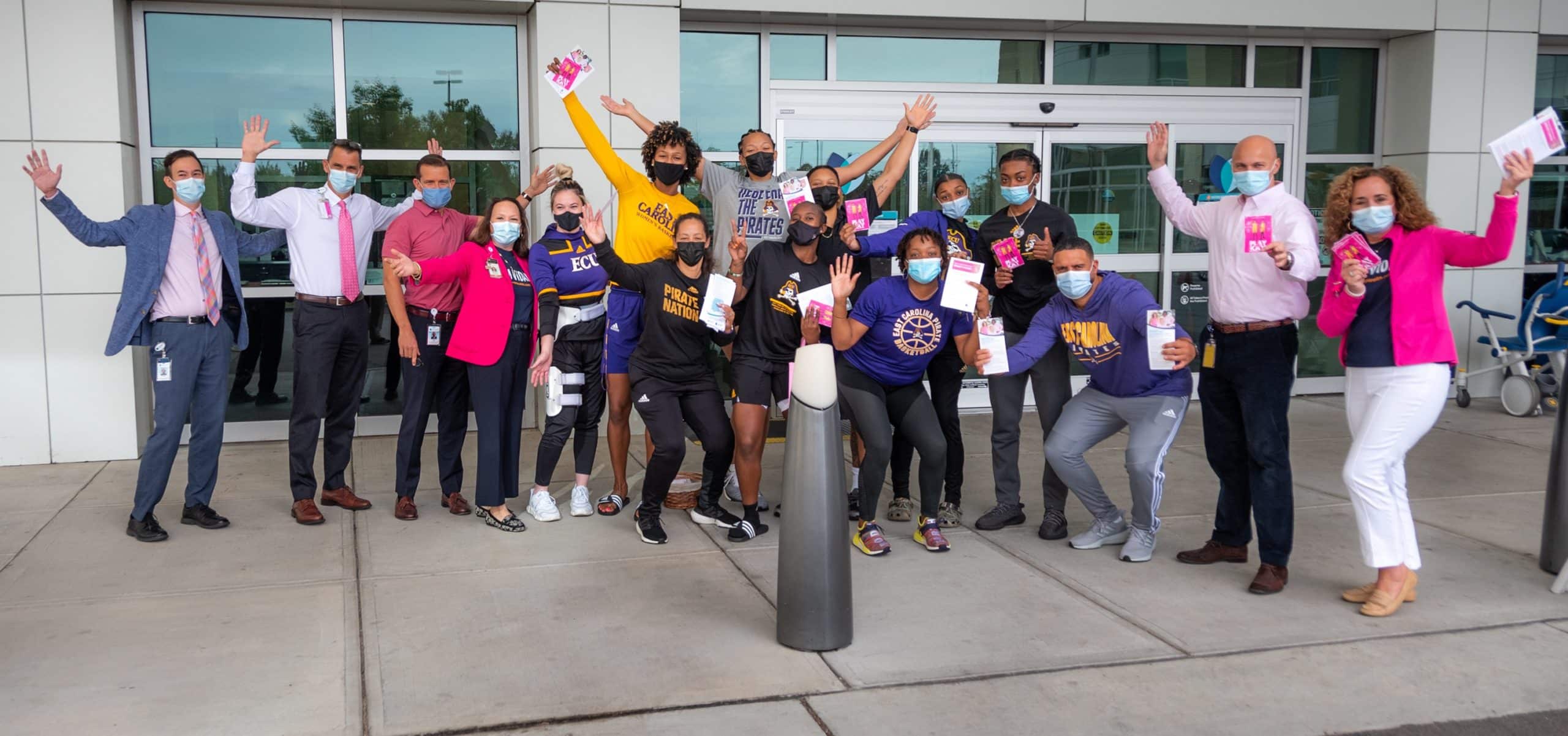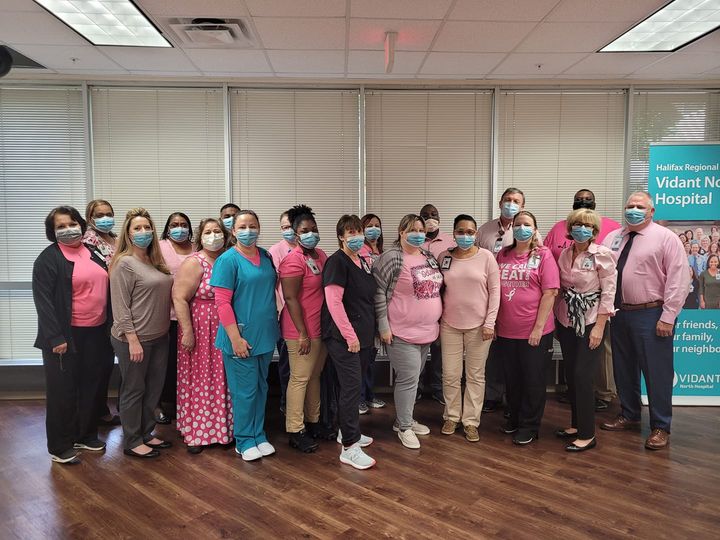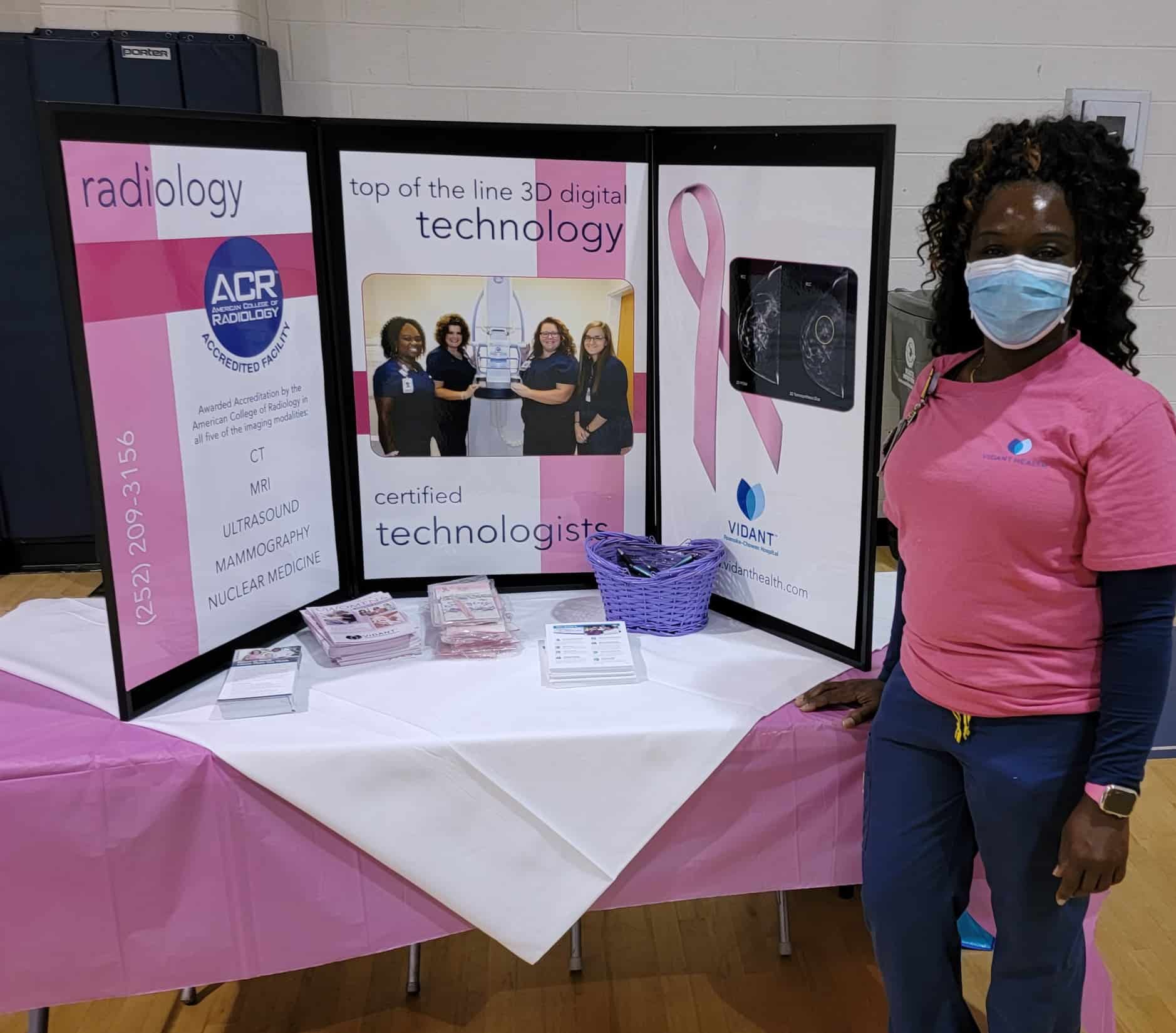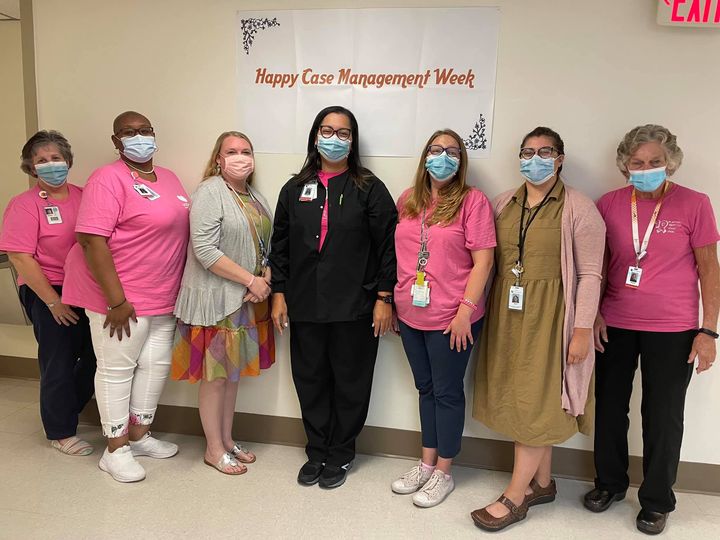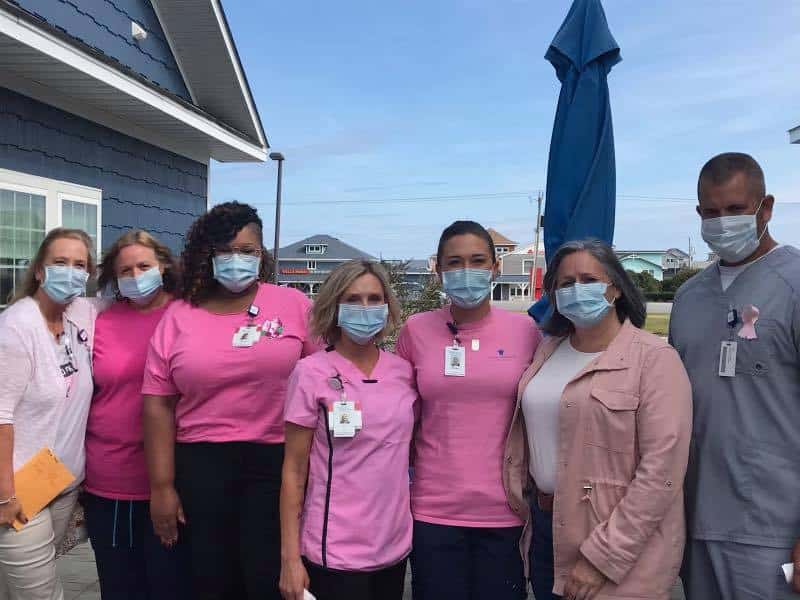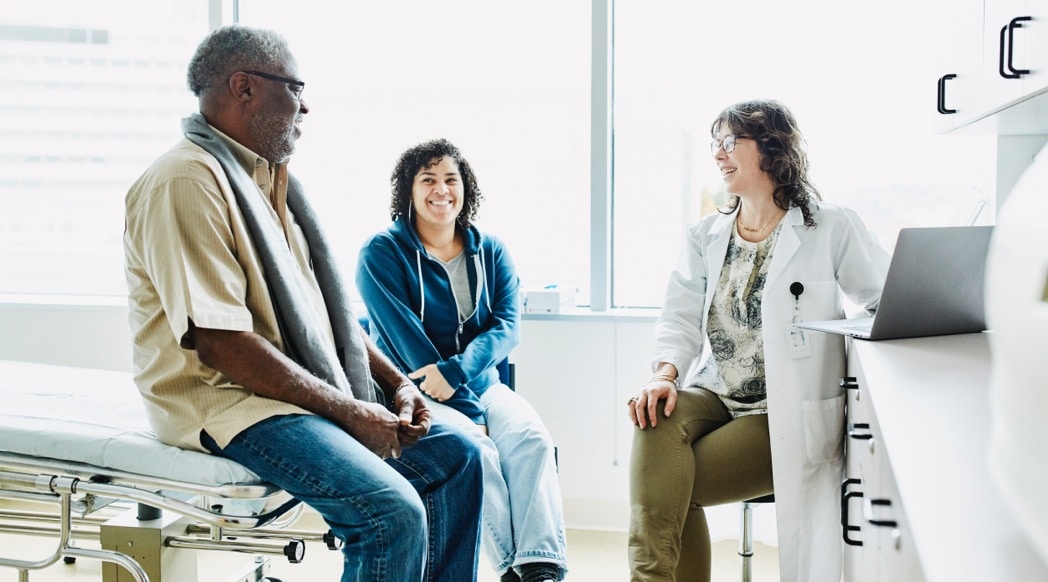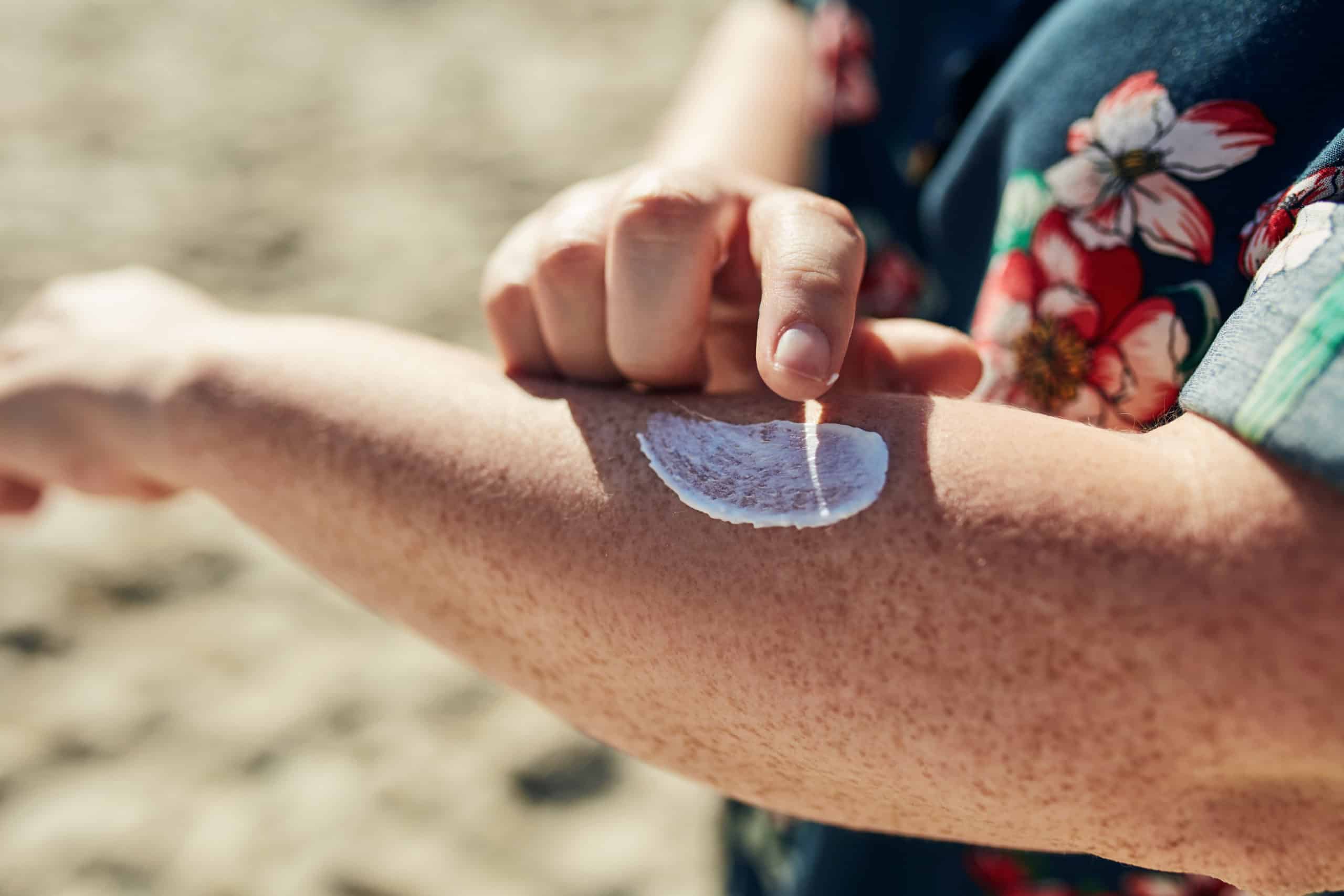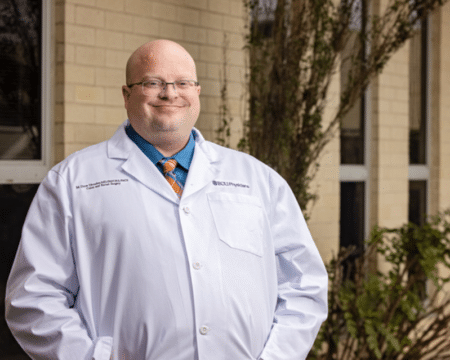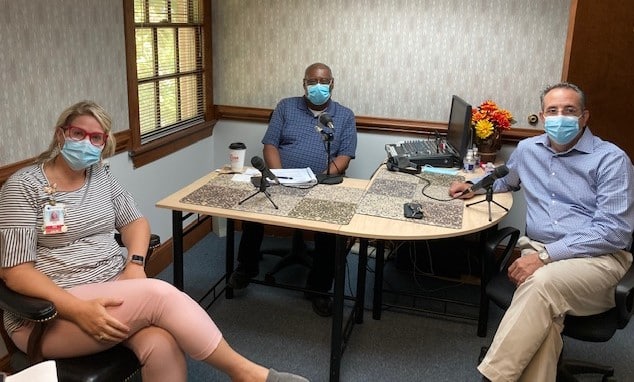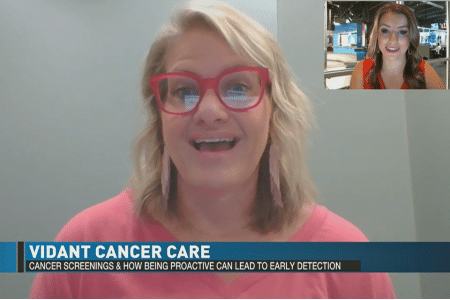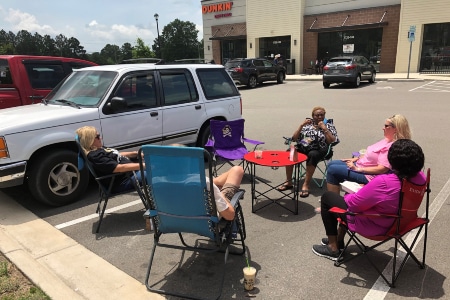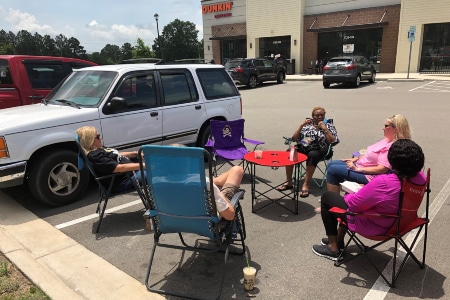October marks Breast Cancer Awareness Month and Vidant Health took the opportunity to promote the importance of early detection, recognize all the fighters and survivors, and honor those lost who lost their lives to the disease.
According to the National Breast Cancer Foundation, breast cancer is the most common cancer in American women, and it is estimated that in 2021, approximately 30 percent of all new cancer diagnoses in women will be breast cancer.
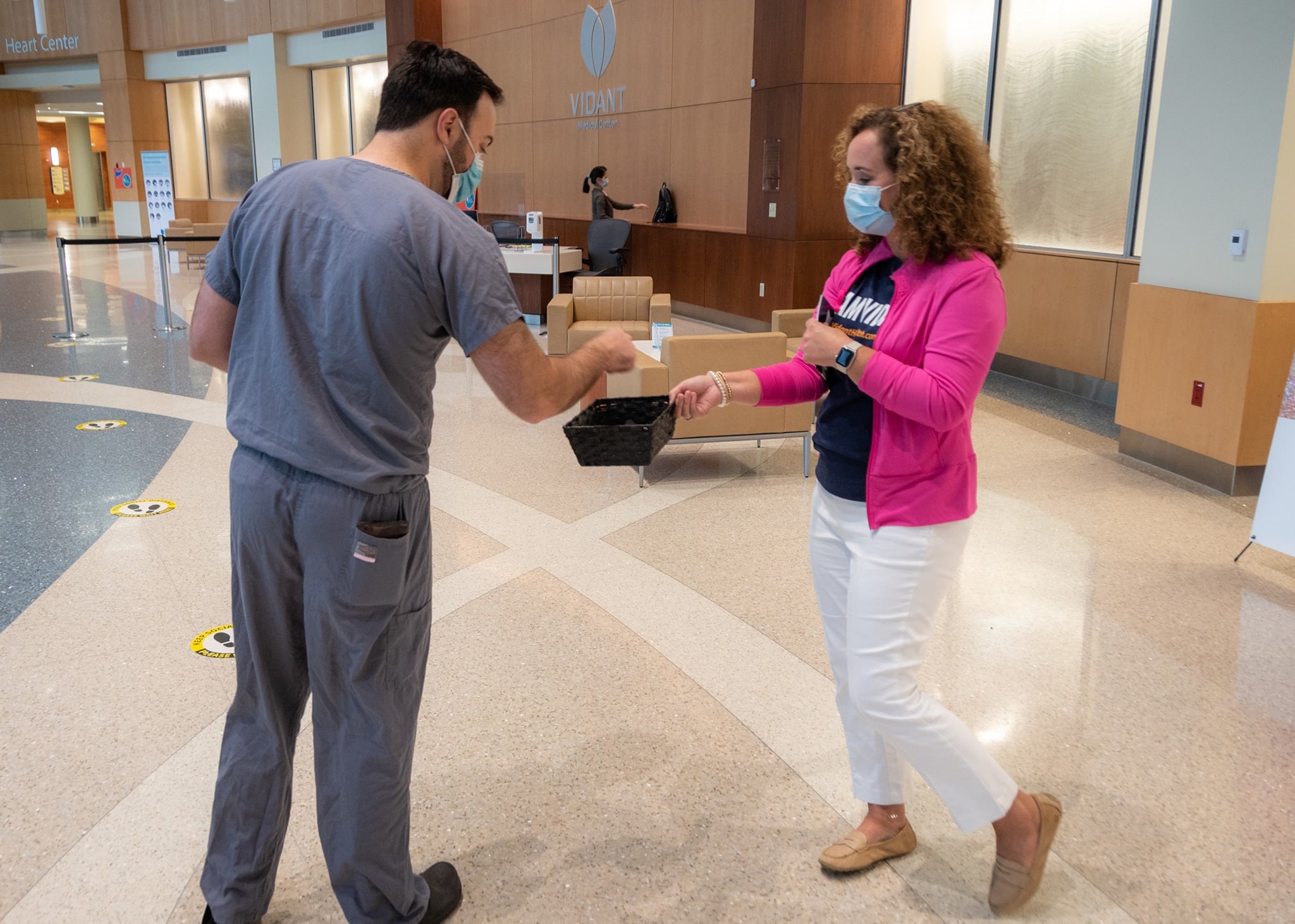
Early detection
Early detection is crucial and Vidant provides access to advanced screening tools like 3D mammography – the most advanced imaging tool available to detect breast cancer.
Dr. Mahvish Muzaffar, a medical oncologist at ECU Health Medical Center (VMC), sat down with WITN to discuss the importance of these screenings. According to the American Cancer Society, screenings have dropped significantly since the start of the COVID-19 pandemic.
Dr. Muzaffar said according to one study, there was a nearly 90 percent drop in breast and cervical cancer screenings. She said the drop was substantial in rural America and among ethnic minorities.
“We know that this may translate into an additional 10,000 lives lost, by conservative estimates, just because of that delay (in screenings),” Dr. Muzaffar said.
She said there are many safety measures in place to protect against COVID-19 when visiting doctors and getting regular cancer screenings.
Women between age 40 and 44 have the option to start screening with a mammogram every year. Women age 55 and older can switch to a mammogram every other year or they can choose to continue yearly screenings.
Visit Vidant’s Events page to see upcoming screening events throughout eastern North Carolina.
Know the risk factors
Knowing your risk factors for any illness or disease is crucial. Understanding what to look for if you are high risk can help save lives. Jennifer Lewis, outreach coordinator with ECU Health Cancer Care, said breast cancer is no different as she joined WITN to discuss risk factors.
“When you do have a first-degree relative which is a sister, mother or daughter, that does double your risk of developing breast cancer,” Lewis said.
Other risk factors include age, as the likelihood of developing breast cancers increases as you get older, alcohol consumption, smoking, weight and lifestyle, and hormone therapies after menopause.
While these steps are important in limiting your chances, the most important thing you can do is contact your primary care provider if you notice any changes.
Wear Pink Day
Each year, Vidant team members across the health system participate in Wear Pink Day to celebrate all breast cancer survivors and to show support and solidarity to those who are still in the fight.
The East Carolina University women’s basketball team showed their support by stopping by VMC to hand out pink ribbons to team members, patients and families at the Eddie and Jo Allison Smith Tower.
View photos from the event below.
To learn more about Vidant’s breast cancer services and connect with care teams, visit ECU Health Cancer Care’s web page.
The COVID-19 pandemic caused the disruption of life as we know it, even some health care was put on hold.
Now, more than a year later, health care providers are concerned with the noticeable drop in the number of people seeking cancer screenings. Dr. Darla Liles, chair of Vidant’s Commission on Cancer Committee joined WNCT to discuss this challenge.
“We want to find cancers in their earliest stage,” Dr. Liles said. “They’re obviously much more curable when they’re stage 1 or stage 2. If we are not screening appropriately, we may end up with cancers that we find more in later stages where they’re not as curable.”
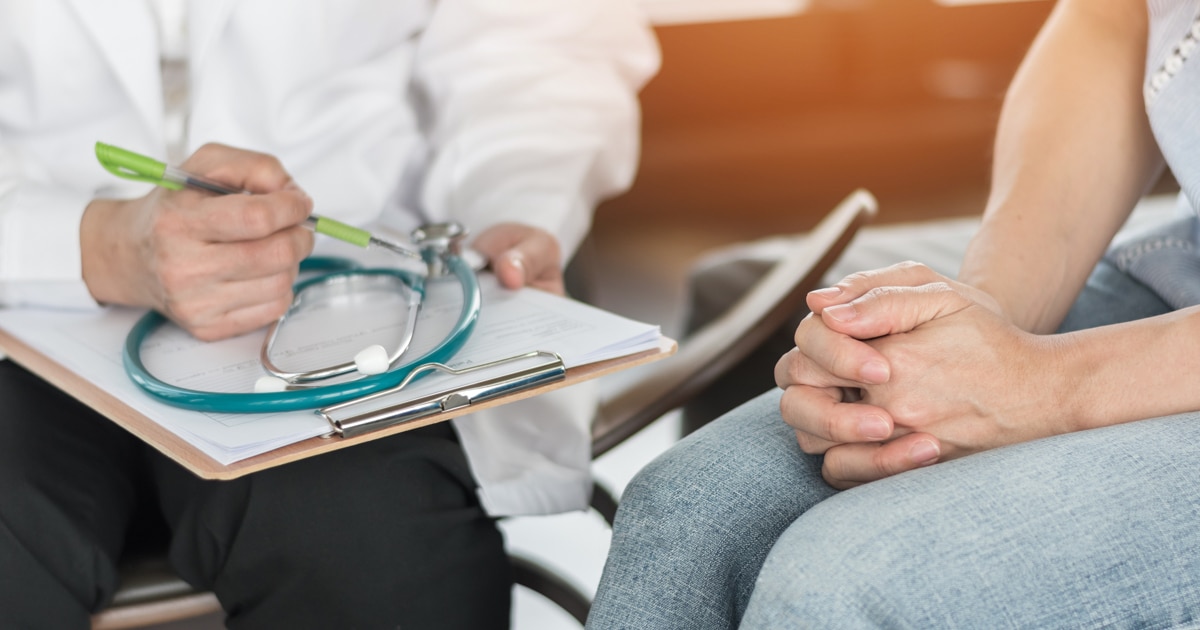
When and where can I get screened?
Regular cancer screenings are available at Vidant Health and Power Up events occur frequently as a way for community members to get screened close to home.
Below is a list of recommended cancer screenings for adult men and women. Use this as a guide, remembering that your health needs are as unique as you are. It’s important to talk with your doctor about how your family history, personal history and lifestyle could affect when you need certain screenings or tests.
Male Adults
All ages:
- Skin cancer: Keep watch on moles and talk about changes with you doctor
After 45:
- Colorectal cancer: Starting at age 45, talk with your doctor about different screening options
- Lung cancer: If you are a current of former smoker and at least 50 years old, there are lung cancer screenings available to you
- Prostate cancer: When you turn 45, talk to your doctor about the need for PSA testing for prostate health.
Female Adults
All ages:
- Breast cancer: Know how your breasts normally look and feel, and talk about changes with your doctor.
- Skin cancer: Keep watch on moles, and talk about changes with your doctor.
Age 19-39
- Cervical cancer: Starting at age 21, you may need regular pap smears. At age 30, continue regular pap smears, and talk about HPV testing with your doctor.
Age 40-64
- Breast cancer: Begin talking about options for regular mammograms starting at age 40.
- Cervical cancer: Continue regular pap smears as recommended by your provider.
- Colorectal cancer: Starting at age 45, talk with your doctor about different screening options.
- Lung cancer: If you are a current or former smoker and at least 50 years old, there are lung cancer screenings available for you.
Tillis announcement serves as reminder
Recently, U.S. Sen. Thom Tillis announced he is seeking treatment for prostate cancer. Doctors are hopeful this high-profile case will serve as a reminder that otherwise healthy individuals still need to keep up with regular screening so that it can be caught early.
“I see a lot of patients who are around Sen. Tillis’ age, who are in general in very good health and have taken care of their bodies and they are not even thinking about having prostate cancer. It’s not on their mind because they are overall doing well,” said Dr. M. Sean Peach, director of brachytherapy services at Vidant Beaufort.
Prostate cancer is the second most common cancer in American men, according to the American Cancer Society, with about one in eight men being diagnosed in their lifetime.
Stay safe in the sun this summer
With the days growing longer and warmer, many people are outside enjoying the sunshine more often. However, prolonged exposure to unprotected skin comes with risks. According to the American Cancer Society, skin cancer is by far the most common type of cancer. It is important to know how to protect your skin as well as the risks, prevention and treatments for skin cancer.
Because exposure to UV rays is one of the most common risk factors for skin cancer, the most important way to lower your risk of skin cancers is to limit your exposure to these rays. Look for ways to reduce sun exposure by using and diligently reapplying sunscreen (with an SPF of at least 30), wearing protective clothing including hats and sunglasses and limiting sun exposure when the rays of the sun are strongest between 10 a.m. to 2 p.m. Also, avoid tanning lamps which give off UV rays and damage the skin.
Dr. Nasreen Vohra is a surgical oncologist and associate professor of surgery at ECU/Vidant Health.
“Remembering the A, B, C, D, E rule for skin cancer, particularly melanoma, is an important step in a skin self-exam,” Dr. Vohra said. “For A, look for asymmetrical shapes to skin lesions. For B, check the borders of these lesions; irregular borders are more concerning. C is for color, take notice if the lesion is unevenly pigmented or if there are changes in color. D is for the diameter of the lesion, and if it is greater than 6 millimeters, or the size of a pencil eraser, this could be concerning. Finally, E is for evolving, so pay attention if the lesion is changing in any noticeable way.”
For more information about the risks and prevention of skin cancer, or if you do not have a primary care provider, contact the Prevention Clinic at ECU Health Cancer Care 816-RISK (7475).
Learn more about cancer prevention, including Vidant’s wide range of services on VidantHealth.com.
As members of the Alliance, Vidant and ECU can offer cancer patients access to a larger pool of state-of-the-art clinical trials at Vidant and ECU clinics. These trials include treatment for breast, gastrointestinal and genitourinary cancers, as well as leukemia, lymphoma, myeloma, neuro-oncology and respiratory cancers.
Health care providers typically must demonstrate their ability to meet an annual average enrollment of at least 15 patients in specific clinical trials for rare cancers over a three-year period in order to become Alliance members. However, the ECU and Vidant organizations combined for 17 patient accruals last year and already have 17 this year, which prompted the Alliance to grant ECU and Vidant membership earlier than expected.
“This is a good thing, because it means that throughout the network here at ECU and Vidant, we are offering more and more trials to our patients, especially patients with more unusual diseases,” said Dr. Darla Liles, chief of the Division of Hematology/Oncology at ECU’s Brody School of Medicine. “Hopefully this encourages more people to consider a clinical trial, because I think there is some hesitancy. I think the more people learn that we have these trials — and they don’t have to go to UNC and Duke for these trials, they can get it done right here — the more they will realize that these are really good things that offer cutting-edge treatments for cancer patients.”
Dr. Emmanuel Zervos, surgical oncologist and director of ECU Health Cancer Care, said the partnership between Vidant and ECU along with gaining membership to the Alliance is crucial to providing more high-quality care to patients in the East.
“Whether in Greenville or at any of Vidant’s Commission on Cancer-accredited community hospitals, the Alliance partnership between ECU and Vidant represents the shared vision of providing state-of-the-art cancer care in our region, regardless of where or by whom that care is delivered,” said Dr. Emmanuel Zervos, surgical oncologist and director of ECU Health Cancer Care. “Cancer services has been at the forefront of collaboration because of the profound impact that cancer has on our region — validation of this collaboration through accelerated full and unrestricted membership into the Alliance assures that these patients will continue to be served both now and into the future.
Visit ECU’s Office of Clinical Trials website or Vidant Health’s Cancer Clinical Trials website for more information on available clinical trials.
Read more about the partnership at ECU News Services.
There are differences in the forms of skin cancer and some, like basal and squamous cell skin cancers, are most common. They start in the top layer of skin and are often related to sun exposure. These cancers grow in the epidermis, the top layer of skin, and are usually removed completely to avoid spreading to other areas. Skin cancers like melanoma, while less common, are more likely to spread if left untreated.
Because exposure to UV rays is one of the most common risk factors for skin cancer, the most important way to lower your risk of skin cancers is to limit your exposure to these rays. Look for ways to reduce sun exposure by using and diligently reapplying sunscreen (with an SPF of at least 30). Also, avoid tanning lamps which give off UV rays and damage the skin.
Knowing your own skin is important to finding skin cancer early. Any spots on the skin that are new or changing in size, shape or color should be checked by a doctor. Any unusual sore, lump, blemish, marking or change in the way an area of the skin looks or feels may be a sign of skin cancer or a warning that it might occur.
“Remembering the A,B,C,D,E rule for skin cancer, particularly melanoma, is an important step in a skin self-exam,” said Dr. Nasreen Vohra, surgical oncologist and associate professor of surgery at ECU and Vidant Health. “For ‘A,’ look for asymmetrical shapes to skin lesions. For ‘B,’ check the borders of these lesions, irregular borders are more concerning. ‘C’ is for color, take notice if the lesion is unevenly pigmented or if there are changes in color. ‘D’ is for the diameter of the lesion and if it is greater than 6 millimeters, or the size of a pencil eraser, this could be concerning. Finally, ‘E’ is for evolving, so pay attention if the lesion is changing in any noticeable way.”
Some doctors and other health care professionals do skin exams as part of routine health check-ups. If the doctor thinks a suspicious area might be skin cancer, the area will be removed and sent to a lab to be examined.
There are different types of skin biopsies. The doctor will choose one based on the suspected type of skin cancer, where it is on your body, its size and other factors. Spread of the cancer deeply below the skin or to other parts of the body is uncommon for squamous cell cancers and rare for basal cell cancers, so most people with one of these skin cancers do not need imaging tests. However, imaging tests such as MRI and CT scans may be done if your doctor thinks you might be at risk for the cancer spreading outside the skin.
Fortunately, most of these cancers and pre-cancers can be cured with fairly minor surgery or other types of local treatments. It is important to discuss all of your treatment options, including their goals and possible side effects, with your doctors to help make the decision that best fits your needs.
“One of the most important factors to remember is skin damage is cumulative and the negative effects on your skin during your early years makes an impact on your skin health as you age,” Dr. Vohra said.
Given this, you should be mindful of ways to reduce your exposure to harmful UV rays, such as avoiding direct exposure when they are the most intense, between 10 a.m. and 2 p.m. Also, wear protective clothing such as hats and sunglasses with prolonged sun exposure. These are important, proactive steps for avoiding skin damage and maintaining skin health.
For more information about the risks and prevention of skin cancer, or if you do not have a primary care provider, please contact the Prevention Clinic at ECU Health Cancer Care at (252) 816-RISK (7475).
Recently, the guidelines for when someone should begin having screenings for colorectal cancer have been updated, and it is now recommended people at average risk for colorectal cancer begin screenings at age 45. The American Cancer Society lowered the age to start screening from 50 because studies show rates of colorectal cancer among people younger than 50 are on the rise and expected to almost double by 2030. Screenings starting at age 45 could help save more lives.
For people of average risk and no family history of colorectal cancer, the first screenings establish a baseline and depending upon the results, will determine the recommended time for the next screening. Regular screenings should continue for people who are in good health through the age of 75.
For people at higher risk for colorectal cancer, there may be reason to start screening before age 45. They may also need to be screened more often or get specific tests. Dr. Drew Honaker, colorectal surgeon & clinical assistant professor, Brody School of Medicine, ECU/Vidant Health, said, “Factors that put those with higher risk include having a strong family history of colorectal cancer or certain types of polyps. Another factor of family history that should be taken into consideration is the presence of a hereditary syndrome such as familial adenomatous polyposis (FAP) or Lynch syndrome.”
It is recommended that people ages 76 through 85 should decide with their health care provider whether to continue to get screened. Factors that should be considered include their personal preferences, prior screening results, overall health and life expectancy. People beyond the age of 85 should no longer be screened for colorectal cancer.
Someone’s personal history may determine an earlier need for colorectal cancer screening. If a person has inflammatory bowel disease, such as ulcerative colitis or Crohn’s disease, if certain types of polyps are present or if there is a history of radiation to the abdomen or pelvis to treat a prior cancer, these conditions will put someone at higher risk.
People who think or know they are at higher risk for colorectal cancer should talk to their health care provider, who can help choose the best screening option and schedule. There are several test options for colorectal cancer which include stool-based screenings and visual exams. Though an invasive procedure, a colonoscopy is the most thorough procedure for preventing colorectal cancer.
In terms of proactive, preventative practices, there are steps you can take to reduce your risk for colorectal cancer. It’s important to maintain a healthy diet that is low in red and processed meats and high in fruits, vegetables and whole-grain fiber. A balance between a healthy diet and lifestyle includes:
- a diet low in red and processed meats and high in fruits, vegetables and whole-grain fiber
- physical activity to help maintain a healthy body weight
- limiting alcohol and tobacco use. Quitting smoking should be a top priority for helping prevent colon cancer and if alcohol is consumed, it should be in moderation
Even if you take all of these steps to reduce your risk of colorectal cancer, you cannot eliminate the risk entirely. That’s why everyone 45 or older should talk to their medical provider, choose a screening test, and get screened routinely.
For more information about the risks, prevention and screening resources for colorectal cancer, or if you do not have a primary care provider, please contact the Prevention Clinic at ECU Health Cancer Care (252) 816-RISK (7475).
One of the most important actions to take to preserve your health is to know your risks and to get a lung cancer screening if recommended by your health care provider. The only recommended screening test for lung cancer is low-dose computed tomography, also called a low-dose CT scan or LDCT.
Dr. Mark Bowling, chief of pulmonary & critical care, and director of thoracic oncology program at ECU and ECU Health Medical Center, said, “Early identification is key and right now the best chance for a cure is early detection and surgical resection. Early-stage lung cancer may not remain early for long, so take action now.”
There are ways to reduce risk for lung cancer that should serve as a checklist to anyone concerned about their health. One of the primary causes of lung cancer is smoking and vaping. Quitting smoking makes a positive impact on lung health. Avoiding secondhand smoke is another factor in reducing lung cancer risks. It is important to have your home or residence tested for radon. This odorless gas is the second leading cause of lung cancer in smokers and the leading cause of lung cancer in non-smokers. Finally, lower exposure to cancer-causing substances at work or in the home. These substances include asbestos, arsenic, nickel and chromium.
Advances in the therapies for lung cancer are encouraging. “Treatments for lung cancer, despite the stage, are advancing at an incredible pace,” Dr. Bowling said. “Hope and optimism for not only long-term control of the disease, but for a cure is in the realm of possibility.”
For more information about the risks and prevention of lung cancer, or if you do not have a primary care provider, please contact the Prevention Clinic at ECU Health Cancer Care (252) 816-RISK (7475)
“The fear of regularly-scheduled health screenings in the time of this pandemic is making a huge impact on early diagnosis, when it is easier to treat cancer,” said Nikki Hyatt, ECU Health Cancer Care outreach coordinator.
Dr. Emmanuel Zervos, surgical oncologist for ECU Brody School of Medicine and Vidant, and executive director of ECU Health Cancer Care, echoed those sentiments, noting that early detection leads to improved outcomes.
“Monitoring patients at risk for certain cancers or who meet recommended age criteria is the key to the early detection. Cancer screening is the best way to detect cancer before symptoms arise,” Dr. Zervos said. “The easiest cancer to treat is the one that never happens. The later we diagnose a cancer, the more limited and less effective treatment options become.”
Screening is recommended as early as age 30 for some cancers, especially in higher risk patients as part of their regular health routine. The American Cancer Society is now recommending PSA testing beginning as early as age 40 for high risk patients like African-American males with strong family histories of prostate cancer.
For breast cancer, mammography screening should begin at age 40 for normal risk patients and 30 for patients with known genetic mutations or syndromes or a history of radiation treatment to their chest between the ages of 10 and 30.
Dr. Zervos shared that anytime you are experiencing symptoms before the recommended age of screening, you should consult your primary care physician. Certain risk factors including race, family history, smoking tobacco and drinking alcohol all factor in to the need to initiate cancer screenings.
For those concerned about their risk for cancer, the Vidant Cancer Prevention Clinic is open and offers information about cancer prevention as well as treatment resources. For more information about the programs and resources at ECU Health Cancer Care, please call 816-RISK (7475).
From February to April, routine cancer screenings dropped 90 percent due to the COVID-19 pandemic, but cancer is not going away. Read more »
Typically, these conversations and meetings would come at various ECU Health Cancer Care events but since the onset of COVID-19, in-person group gatherings have been put on hold.
Dale Naylor, a breast cancer survivor, said after the last meeting at ECU Health Medical Center in early March, she made it about a month before she had to get out and see what she calls “her family” in the survivorship group. The group has set up in front of FreshVibes once a week since early April to get together and enjoy each other’s company while practicing social distancing.
“It started with two pickup trucks, we were sitting on the tailgates,” Naylor said. “The next week when we came, we sat out in a parking space and put some chairs out and we’ve been doing it ever since the first week of April.”
The group has been finding some sense of normalcy in these get-togethers and sharing in each other’s journey is helping everyone through a challenging time.
Naylor said the best part about the group is how close they have become and their openness and honesty with one another.
“It’s wonderful because not only have we experienced similar journeys, but we’ve grown into a very cohesive group. It’s like missing part of your family,” Naylor said. “This has pretty much helped all of us stay sane, so to speak.”
Along with these weekly informal meet ups, the group has been meeting with Jenny Higgins, a psychosocial support and survivorship coordinator with Vidant Health, via video conferences for different classes each week.
“Right now, we’re doing everything via (video calls), we do knitting together, journaling, art class and now we’re doing yoga. It’s good to have some kind of normalcy,” said Charlotte Forjoe, a breast cancer survivor.
Forjoe said she received her care at Vidant and the patient-centered approach, from the attitude of valet service to the personal touch of the doctors, made all the difference. The services available through the survivorship program have been crucial for Forjoe.
“These classes that are free to us, it was a way for us to come together and we all had a common bond – and that was cancer,” Forjoe said. “Family is great, but people who have experienced it and that you can talk to and be open with, without judgement, that’s what you need sometimes.
“Even though I had family, I kind of gravitated more toward this group. They became my extended family and the family that I needed at that time to help me emotionally through it,” Forjoe said.
Like Naylor, Forjoe said the group has become an extension of her family and having the extra support system in place has helped her through her cancer journey.
She said she even makes a point to seek out patients at Vidant and in the community to tell them about the program and let them know of upcoming events.
“I’m that much of a believer in what Vidant offers and what they give to you as you’re going through that process,” Forjoe said.
For Forjoe, the survivorship group is about much more than surviving after a cancer diagnosis. She sees herself, and the other members of the survivorship group, taking advantage of a new outlook on life, and truly thriving.
“I’m a thriver. I’m going to live life,” Forjoe said. “To me, just surviving means you’re going through life, but I’m thriving, I’m going, and I’m not going to let cancer stop me or beat me. So I’m thriving – and we all are.”
A group of five cancer survivors met outside of FreshVibes on Arlington Boulevard in Greenville on an overcast Wednesday – just a few days after National Cancer Survivors Day earlier this year – to talk about their cancer journey, the latest happenings in the news and recent beach visits. Read more »
